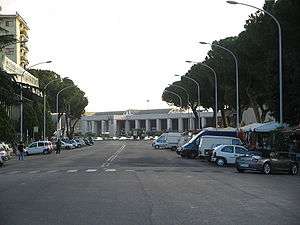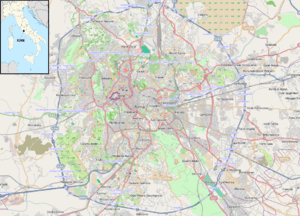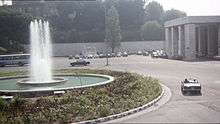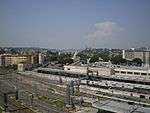Roma Ostiense railway station
Roma Ostiense | |
|---|---|
 Station building seen from Porta San Paolo | |
| Location |
Piazzale dei Partigiani 00100 Rome Italy |
| Coordinates | 41°52′22.15″N 12°29′4.98″E / 41.8728194°N 12.4847167°ECoordinates: 41°52′22.15″N 12°29′4.98″E / 41.8728194°N 12.4847167°E |
| Owned by | Rete Ferroviaria Italiana |
| Operated by | Centostazioni |
| Line(s) | Pisa-Livorno-Grosseto–Roma |
| Distance |
6.692 km (4.158 mi) from Roma Termini |
| Platforms | 6 (11 tracks) |
| Connections |
Rome Metro (Line B)[1] |
| History | |
| Opened | 1940 |
| Electrified | 3,000 V |
| Location | |
 Roma Ostiense railway station (Rome) | |
Roma Ostiense is a railway station in Piazza dei Partigiani serving the Ostiense district of Rome, Italy, a short distance from the Porta San Paolo. It is run by the Centostazioni arm of the Ferrovie dello Stato group and the urban rail lines FR1, FR3, and FR5 run through the station. It is linked with the Piramide Metro B station and the Roma Porta San Paolo station on the Rome-Lido railway line.
History

To commemorate the forthcoming visit of Adolf Hitler to Rome in 1938, the current Ostiense station was built, replacing an existing rural railway station, with the aim of creating a monumental station to receive the German dictator. A new road was also built to connect the station with Porta San Paolo - this was initially named Via A. Hitler but, after World War II, it became Viale delle Cave Ardeatine.
Hitler's visit to Rome is cinematically recreated in director Ettore Scola's film Una giornata particolare, who also used archived newsreel footage showing the actual meeting between Hitler, Benito Mussolini, and Victor Emanuel III.
The building
Italian architect Roberto Narducci designed the station. In addition to being built in the architectural style favoured by Hitler, the design of the station's marble facade was almost identical to that of the Italian pavilion at the 1942 Rome World's Fair (a design never fully realised due to the Second World War). The station building was inaugurated on October 28, 1940.
The entire facade is made of Travertine marble and the entrance is marked by a columned portico. On the right side of the façade is a relief by Francesco Nagni representing the mythical figures of Bellerophon and Pegasus. On the left is a fountain built in 1957. A mosaic on the floor made of black and white tiles demonstrates various themes and legends of Rome's history.
South of the tracks, the station authority constructed a new section to help Ostiense serve as a terminal station for passengers arriving from Leonardo da Vinci Airport during the 1990 World Cup, which accumulated a variety of commercial activities. However, following the decline in the number of passengers after the end of the World Cup, the new section was quickly abandoned and the various shops that were housed there began to close. In 2012, the building was converted to a new branch of Mario Batali's restaurant/maket chain Eataly.
The square

The square outside of the station was named Piazzale dei Partigiani during World War II. Now, the square's primary function is a bus terminal and parking facility. Before 1990, however, the piazza was embellished with a well-maintained garden and a now-nonfunctioning fountain that was built in the 1950s as part of the design of the station's architect Roberto Narducci. The fountain was inexplicably excluded from the modernization and renovations for the 1990 World Cup, even though the square was part of the ambitious "Cento Piazze" beautification project.[3] The small palm gardens that surround the parking lot are today occupied by a number of homeless people, asylum seekers, and political refugees.[4] Every Monday and Friday, Red Cross volunteers use the square to distribute food to the city's homeless population, despite protests from the area's residents who say that the organization arbitrarily selected the site.[5]
Services
Interchanges
-
 Piramide station on Line B on the Rome Metro.
Piramide station on Line B on the Rome Metro. -
 Roma Porta San Paolo station on the Ferrovia Roma-Lido.
Roma Porta San Paolo station on the Ferrovia Roma-Lido. -
 3 - 23 - 30 express - 75 - 83 - 118 - 280 - 673 - 715 - 716 - 719 - 769.
3 - 23 - 30 express - 75 - 83 - 118 - 280 - 673 - 715 - 716 - 719 - 769.
Gallery
 Ostiense station shortly after completion in 1940
Ostiense station shortly after completion in 1940View of the lines from the entrance of Cristoforo Colombo highway Station and piazzale 
The station from a neighbouring building, with the Piramide station in the background
Notes and references
- ↑ At Piramide station
- ↑ At Roma Porta San Paolo station
- ↑ "Cento Piazze" - Comune di Roma Archived November 17, 2006, at the Wayback Machine.
- ↑ , Report in "Il Messaggero" 18 July 2008
- ↑ , Report in "Corriere della Sera" 15 October 2006
See also
- Roma Termini
- Roma Tiburtina
- History of rail transport in Italy
- List of railway stations in Lazio
- Rail transport in Italy
- Railway stations in Italy
External links
![]() Media related to Roma Ostiense railway station at Wikimedia Commons
Media related to Roma Ostiense railway station at Wikimedia Commons
| Preceding station | Lazio regional railways | Following station | ||
|---|---|---|---|---|
toward Orte | FR1 | toward Fiumicino Aeroporto |
||
| Terminus | FR3 | toward Viterbo Porta Fiorentina |
||
toward Roma Termini | FR5 | toward Civitavecchia |